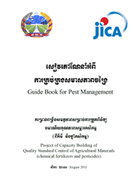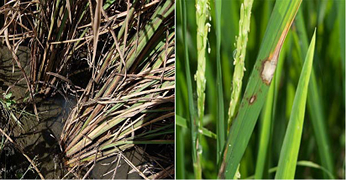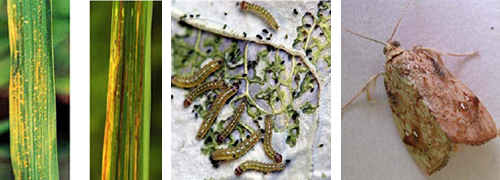- Home
- Technical Cooperation Projects
- Index of Countries
- Asia
- Cambodia
- Capacity Building for the Quality Standard Control of Agricultural Materials (Chemical Fertilizers and Pesticides)
- Project News
- "Guide Book for Pest Management" was finally completed
Project News
2011-09-12
"Guide Book for Pest Management" was finally completed
Since Project of Capacity Building for Quality Standard Control of Agricultural Materials (QCAM Project) announced its plan to introduce a "Guide Book for Pest Management" at a Project Seminar in Phnom Penh in December 2010, the QCAM Project has been working on the Guide Book and finally completed it in two versions of Khmer and English (Photo 1). This Guide Book targets rice and Chinese cabbage, both of which are commonly grown in the project pilot areas of Kandal Province, identifies major pests for those crops, introduces the Integrated Pest Management (IPM) methods by following the guidelines of Cambodian Ministry of Agriculture, Forestry and Fisheries (MAFF) and applicable active ingredients of pesticides against each pest as the last measure only when the IPM methods does not effectively work against it. Concretely, in order to enable users of the Guide Book including retailers of pesticides, farmers, inspectors and extension workers, to easily understand the contents, the Guide Book is consisted of (1) Symptoms and Damages of Pests (Photo 2), (2) Identification of Pests (Photo 3), (3) Identification of Pest Causes, (4) Concepts of the IPM and How to Read Labels of Pesticides, and (5) Identification of Applicable Active Ingredients of Pesticides against Pests with many color photos.
 Photo 1: Guide Book for Pest Management.
Photo 1: Guide Book for Pest Management.
 Photo 2: Part of Symptoms and Damages of Pests in the Guide Book.
Photo 2: Part of Symptoms and Damages of Pests in the Guide Book.
 Photo 3: Parts of Identification of Pests in the Guide Book.
Photo 3: Parts of Identification of Pests in the Guide Book.
Farmers need to refer to the directions for use on the label when actually using the pesticide, but this Guide Book only goes as far as introducing effective and active ingredients of pesticides, following the MAFF guidelines. This implies that there must be another material or document which tells the retailers and farmers which pesticide products should be selected and properly used. Therefore, the QCAM Project is planning to request local licensed distributors and agents of pesticides to compile a document as Guide Book Part 2, which enables the retailers and farmers to identify a product to buy and the proper way to use it by referring to the active ingredients identified in the "Guide Book for Pest Management" (Guide Book Part 1).
This Guide Book already has good reputations from other development project and organization like the Regional Economic Development Program by the GIZ and the VVOB, a Belgian NPO. They already requested the QCAM Project to make 50 copies for each by their own expenses.
Finally, we hope that Cambodian people will be able to properly deal with the pests and enhance the qualities of their agricultural products and productivity by using the Guide Book.
Note 1: According to the Food and Agriculture Organization (FAO), the IPM is defined as "a pest management system to discourage the development of pest populations to levels that are economically justifies and maintain the levels by using all available pest control techniques and subsequent integration of appropriate measures."
Written by Toshinori Hamaguchi, JICA Expert
- About JICA
- News & Features
- Countries & Regions
- Our Work
- Thematic Issues
- Types of Assistance
- Partnerships with Other Development Partners
- Climate Change / Environmental and Social Considerations
- Evaluations
- Compliance and Anti-corruption
- Science and Technology Cooperation on Global Issues
- Research
- JICA Development Studies Program / JICA Chair
- Support for the Acceptance of Foreign HRs / Multicultural and Inclusive Community
- Publications
- Investor Relations
